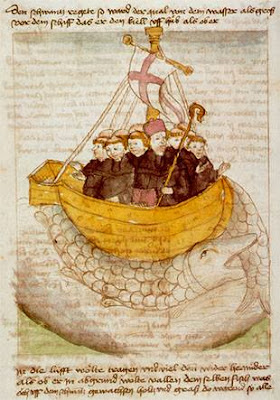Mairgead Mór “Big Fair Day”
Over most of Western Europe, particularly in those areas connected with the ancient Celts, December 21, the shortest day of the year fell during the Druidic festival of 'Yule'. Today it is better known as the festival of the ‘Winter Solstice’.
‘Thoul’, an ancient word for wheel, has been handed down to us as Yule. The sun was likened by the Celts to a wheel, traversing the heavens, giving long and short days. The shortest day, and thus a good reason to be of good cheer in anticipation of longer days ahead, was known as Yule. This celebration of light survives in many of our Christmas traditions with the hanging of mistletoe (a white berry), Holly (a red berry) and the lighting of the Yule-log, whose faint light kick-started the longer days Spring. It was an exciting festival for the ancient Celts, coming as it did at the darkest time of year.
In Ireland Yule was eventually replaced by the Catholic traditions surround the religious feast-day of the Immaculate Conception, on the 8th of December and the longer festival of Christmas. However, outside the city, the old pagan traditions continued to be marked by the holding of the Mairgead Mór or the "Big Fair Day, in country towns all around Ireland.
"Brian Nolan, a Loughrea, County Galway native, remembers it as a day of great celebration, when farmers would converge on town to sell their crops, livestock, and poultry, and women would come with them to spend their "butter and egg money" on holiday gifts and goodies.
According to Nolan, "Mairgead Mór was an amazing sight to me as a child in the early 60s before marts and supermarkets modernized everything. On that day, everyone came to town — the ruddy-faced, wool-capped men with their sturdy womenfolk; the too-thin gaggles of wide-eyed children — on horses, in donkey and cart, on bicycles, and on foot, and everyone carried something for the fair. They arrived before dawn, and left, a mess of straw and leavings behind them, after dark".
"Geese by the hundred, turkeys and chickens by the thousand, all 'live,' tied to the back of upturned donkey carts between loads of turf. Mounds of potato sacks brimmed with Kerrs Pinks and Banners from Clare; huge heads of cabbage and turnips; bunches of parsnip and carrots, and the very rare bushel of brussels sprouts. Wheels of hardy cheddar, and what seemed like acres of flats of eggs in hues of brown and white, with the bigger duck-eggs, bluish in the winter sunlight".
"The fowl would be raucous, hog-tied or closeted in bushel baskets with their heads poking out, or in more modern times, poking their heads out of car-boots, and all cackling and clucking and gobbling away to their hearts' content. The 'townies' and some city market buyers made their canny way, back and forth between the rows of sellers, examining here, feeling there, commenting on the size and weight, and what they were fed on, and whether they were spring or summer birds".
"Amid all that was the excitement of the shops, the bustle of the women going in to settle their account with the harvest, butter, and turkey money enabling them to pav down their tab and get some new clothes for themselves and the children, now wide-eyed in expectation and appreciation of the beautiful goods and sweet chocolates they were able to see and touch now and maybe even take home".
December 21st was one of the most important dates in the Celtic calendar as it marked the celebration of a farmer's success and the approach of the New Year. The Mairgead Mór did not always co-incide with December 21, in fact it was usually held on the Wednesday or Thursday that fell in the week after the next Sunday after December the 8th, the Feast of the Immaculate Conception. So it was held approximately a week or so before Christmas, giving folks enough time to kill, hang and pluck their turkey or goose.
These days In modern Ireland, the Mairgead Mór is no longer held, it's now just another big shopping day before Christmas, but in country folks’ minds, the time for cutting mistletoe is nigh and they’d best be getting the turkey ready for market’ Today, the 18th of December would have been a perfect Mairgead Mór.
------------------------------------
This story is typical of the stories I tell on my Galway's Horrible History Walking Tours. Check out www.galwaywalks.com or contact me at galwaywalks@gmail.com
This particular story 'Mairgead Mór', which I mostly wrote over a decade ago, appears in edited form in Margaret Johnson’s latest cook book, ‘Christmas Flavors of Ireland’ which is available now through her website or on Amazon. The book is delightfully written and presented and would make a lovely gift anytime.
This particular story 'Mairgead Mór', which I mostly wrote over a decade ago, appears in edited form in Margaret Johnson’s latest cook book, ‘Christmas Flavors of Ireland’ which is available now through her website or on Amazon. The book is delightfully written and presented and would make a lovely gift anytime.
It is published by Ambassador International., Belfast, N. Ireland
Margaret M. Johnson www.irishcook.com or www.margaretmjohnson.com



